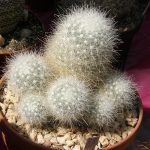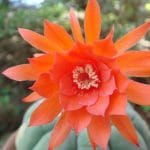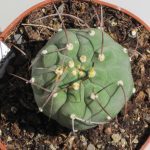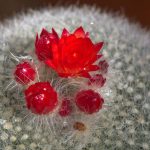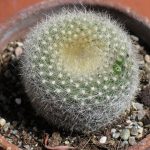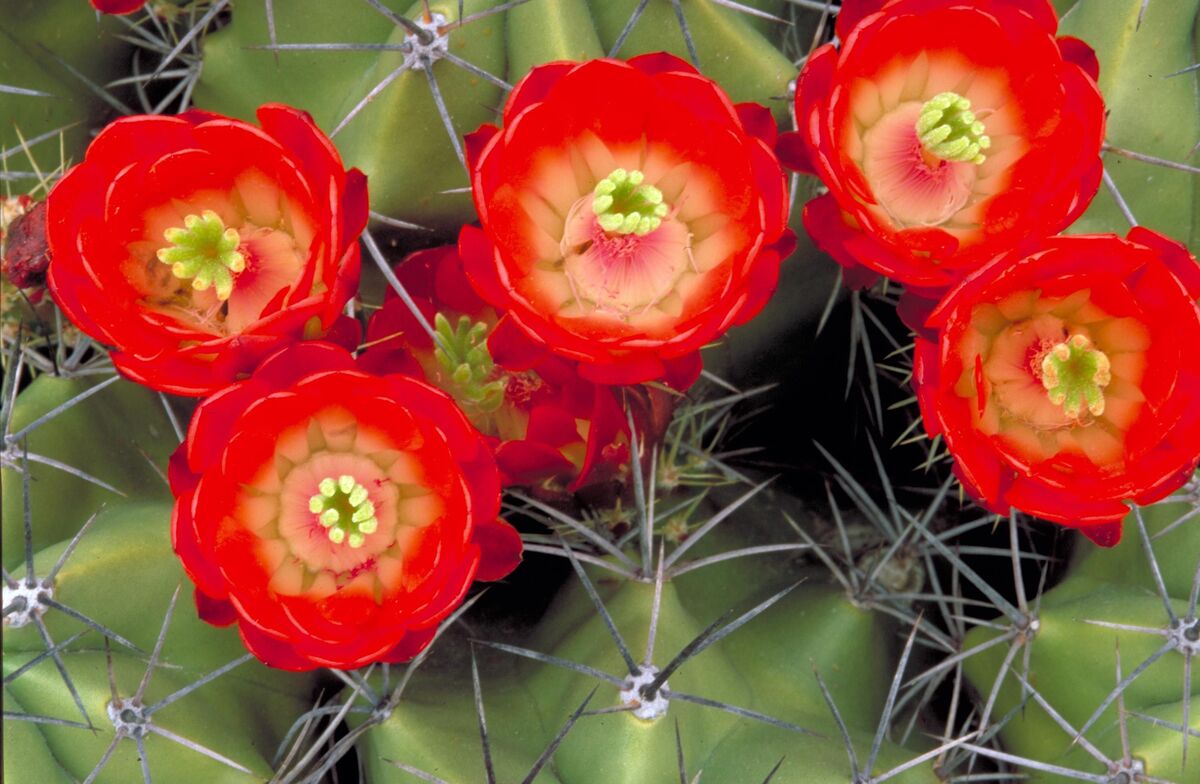
Red flowers are beautiful: large or small, with one or more crowns of petals, red is a color that attracts us, and the best thing is that there are a few types of cacti that produce them.
If you want to know their names, characteristics and, what is more important if possible, the general care that you have to provide them, then we are going to present them to you. So if you have a place to put a few copies, you can choose well which one to buy.
Echinopsis chamacereus
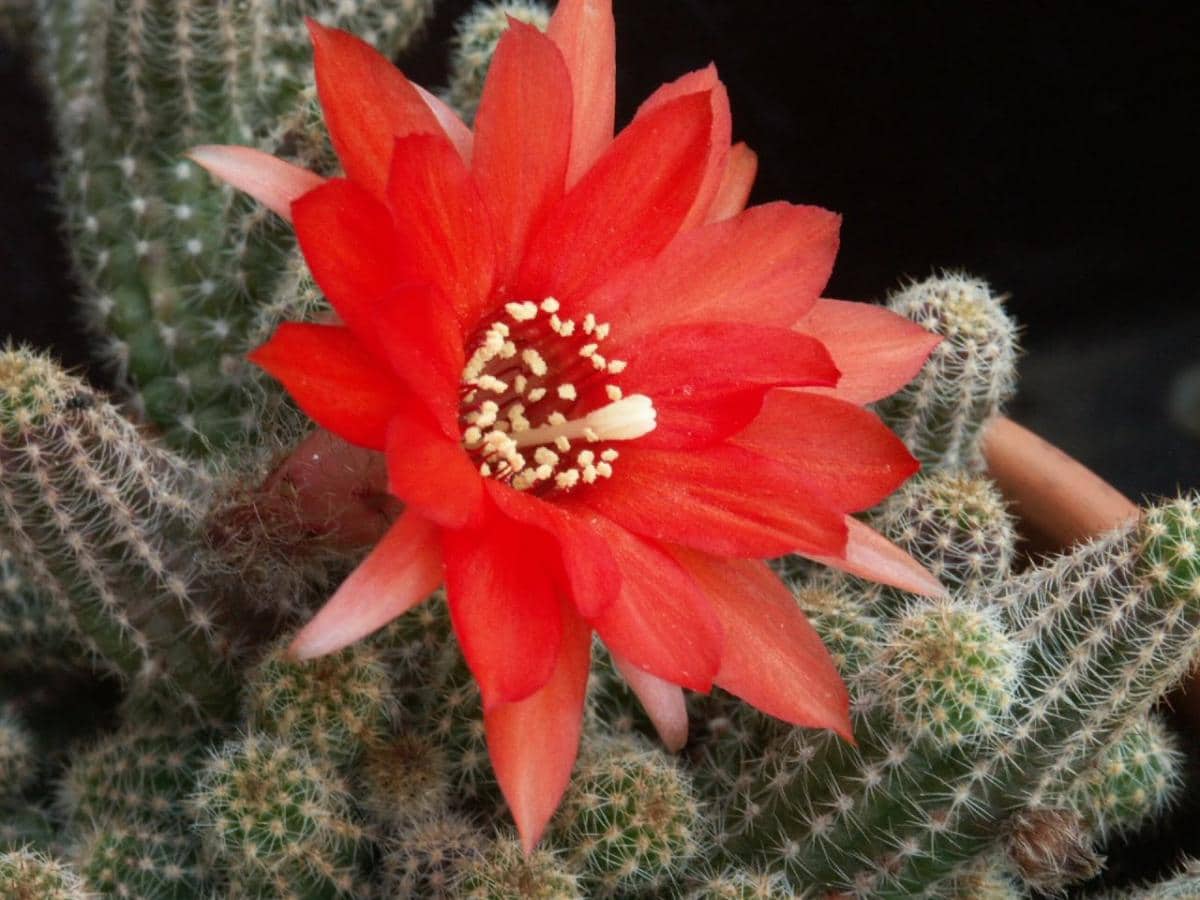
Image - Wikimedia / Moni Sertel
El Echinopsis chamacereus is a cactus with creeping or hanging stems endemic to Argentina. Its maximum height does not usually exceed 20 centimeters, although it can extend up to 40 centimeters. From its areolas sprout between 10 and 15 thorns, as well as its flowers, which are hermaphrodite and red. It blooms in spring and into early summer (more or less, from May to July in the Northern Hemisphere).
Care
It is a plant that can be both in full sun and in semi-shade, in pots or in the garden. It needs little care, just water it from time to time, and if you want to prune it in spring. Resists cold, as well as frosts down to -8ºC as long as the ground is dry; even so, it is better not to drop below -3ºC.
Echinopsis cinnabarina (before lobivia cinnabarina)

Image - Cactus Art
El Echinopsis cinnabarina It is a small cactus endemic to Bolivia. Its body is globular, green in color, and measures 15 centimeters in diameter by 7-10 centimeters high.. Eight to twelve radial spines that measure between 0,5 and 1 centimeter long, and two-three central ones of approximately the same size sprout from each of its areoles. Its flowers are scarlet red, and measure up to 4 centimeters in diameter.
Care
It is a cactus that needs direct sun so that it can grow in conditions. In addition, the soil must be light, so much so that in a pot it is advisable to have it in a mixture of black peat with perlite in equal parts, or with pomx. It does not resist waterlogging, so it has to be watered very occasionally. It resists up to -7ºC if the soil is dry.
Ferocactus gracilis

Image - Wikimedia / H. Zell
El Ferocactus gracilis It is an endemic cactus from Mexico with a spherical shape. Its maximum height is 150 centimeters, and it has a diameter of 30-35 centimeters. It has around 16 and 24 ribs, with whitish areoles from which 7-13 central red spines sprout up to 7 centimeters long, and 8-12 white radial spines. The flowers sprout at the top, are red and are 3,5 centimeters in diameter.
Care
It is a very grateful species, ideal for planting in a cactus garden or desert plants, in full sun and in well-drained soils. It can also be kept in pots for years, with a substrate for cacti for example. It needs few waterings, since it resists drought but not excess water. In addition, supports up to -4ºC.
Mammillaria senilis
- Image - Wikimedia / Michael Wolf
- Image - Wikimedia / Andrew Butko
La Mammillaria senilis, known as the old man's head biznaga, is an endemic cactus of Mexico belonging to the genus Mammillaria. It develops a cylindrical or globose stem whose height is 15 centimeters and a maximum diameter of 12 centimeters. The areolas are ovate, and about 4 central spines sprout from them, and other finer and shorter radial spines. Its flowers are funnel-shaped, measure about 4 centimeters in diameter, and are orange-red in color.
Care
It is a cactus plant that has to be grown outdoors, in a sunny area. If that is not possible, you can live in semi-shade, but it is necessary that in the place where you are there is a lot of clarity. It will be watered sporadically, always trying to avoid excess water, since it would not resist it. It supports weak and occasional frosts of up to -2ºC.
Matucana madisonorum
- Image - Wikimedia / msscacti
- Image - Wikimedia / Petar43
La Matucana madisonorum It is an endemic cactus of the Peruvian Amazon. His body is globose, and measures 10 centimeters high by 15 centimeters in diameter. It has some spines, mainly in its upper part, and they are brownish or whitish in color, with a length of up to 3 centimeters. The flowers are funnel-shaped, 10 centimeters long by 5 centimeters in diameter, and are orange-red. It is a critically endangered species in its place of origin.
Care
It will grow in a bright corner, better outdoors than indoors, since indoors it will be difficult for it to develop well unless you buy a lamp that stimulates its growth. The soil, or the substrate if you are going to have it in a pot, must be composed of a mixture of garden soil or peat and perlite in equal parts. Give it a sporadic watering, once a week or so. Withstands occasional frosts down to -1,5ºC.
Haselbergii parody (synonymous Notocactus haselbergii)
- Image - Wikimedia / Averater
- Image - Wikimedia / Petar43
La Haselbergii parody It is an endemic cactus in Brazil that tends to form small groups. Its body is spherical, green in color, and measures 10 centimeters high by 15 centimeters in diameter. It has about 30 ribs with areoles from which whitish spines sprout. It blooms in early spring, producing red or orange-red flowers 2 centimeters in diameter.
Care
Place your Parody in a sunny area, so that it can grow healthy. You can have it in the garden, for example in a rockery, but only if the soil has good drainage; if not, make a hole of about 50 x 50cm, and fill it with pumice or some similar substrate. Water it when you see that the soil is drying out. It supports the cold, but if there is frost it will need protection.
Rebutia pygmaea var colora

Image - Wikimedia / Otakar Sida
La Rebutia pygmaea var colora is a small, globular cactus with an olive-green to purplish-brown body that is about 10 centimeters tall. Short spines sprout from their areolas, about 0,5 centimeters long, but sharp. The flowers are red and are about 2-3 centimeters in diameter. These appear forming a crown, making the plant look very pretty.
Care
In cultivation it is an easy cactus to care for. It must be kept in full sun (but it is important that you get used to it little by little if you never gave it before), and in a pot or in a soil that drains water quickly. Irrigation will be scarce, only when the land is dry. Resists up to -4ºC.
Which of these cacti with red flowers did you like the most?

